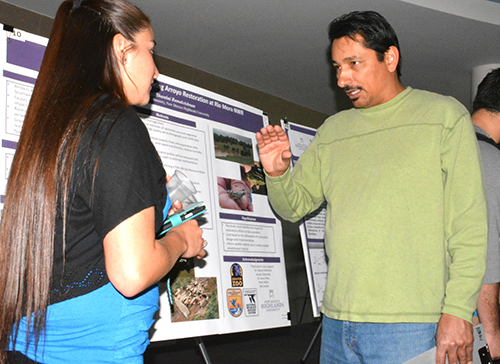April 22, 2015

Margaret McKinney/Highlands University
Highlands University natural resources management professor Edward Martínez, right, talks with Eliza Montoya about her research poster at Research Day 2015.
Las Vegas, New Mexico – Highlands University named natural resources management professor Edward Martínez as Professor of the Year for 2014 – 2015.
A coalition of 21 Highlands science students nominated Martínez for the honor, writing: “As an instructor, Dr. Martínez consistently brings interest and passion to every lecture, field trip, and lab exercise, along with ensuring that every assignment is more challenging than the last. This enthusiasm spread to his students, which increases students’ thirst for knowledge and commitment to goals.”
Each spring an independent selection committee comprised of students, faculty and staff reviews the nominations from students for the Professor of the Year honor and selects a winner.
“Dr. Martínez is very inspiring because he both teaches and models perseverance and tenacity in scientific research,” said Lorraine García, natural resources management graduate student. “He’s exceptionally dedicated to all students and works so hard to bring research opportunities to the university for us.”
Martínez is García’s thesis adviser.
“My study is examining how climate changes like decreased snowpack can influence arsenic concentrations in the water and sediment in the Jemez River and its tributaries in the Jemez Mountains. Less snowpack can decrease the dilution of arsenic in the water to levels that don’t meet EPA safety standards for humans and livestock,” García said.
Martínez earned his doctorate in environmental and natural resource sciences with an emphasis in aquatic toxicology from Washington State University.
He joined the Highlands faculty in 2005 and established a Water Quality Laboratory. Martínez teaches courses such as research methods, quantitative methods, watershed management, water science, and limnology – the study of fresh water.
“It was gratifying to be nominated by such a cross section of science students – ranging from ones I advise to others I have only taught in one class,” Martínez said. “I want every student I work with to become confident and go on to successful science careers.”
He said his experience earning his B.S. in environmental science at Highlands influenced his teaching style.
“When I was an undergraduate student at Highlands, I had a mentor who believed in me. This is what I try to do for my students and it motivates me every day,” Martínez said.
Martínez also directs the university’s award-winning ARMAS program, or Achieving in Research, Math and Science. Originally funded in 2009 with a $2.2 million U.S. Department of Education grant, ARMAS provides comprehensive support services to science, technology, engineering and math (STEM) students and faculty at Highlands.
Martínez and Elizabeth Ratzlaff, ARMAS coordinator, have worked together to obtain ongoing grant funding for the program.
Overall, Martínez has secured approximately $7 million in grant funding for the university through collaboration with colleagues from Highlands and other institutions. The majority of the grants focus on student recruitment, retention and graduation in STEM disciplines.
Examples of granting agencies include the National Science Foundation, New Mexico EPSCoR – Experimental Program to Stimulate Research, W.K. Kellogg, and U.S. Department of Agriculture,
In the research arena, Martínez said a primary focus of his work at Highlands is to provide students with the opportunity to be involved in significant and publishable research that addresses current water pollution issues.
“The research that the students and I conduct often uses aquatic invertebrates – insects – as indicators of heavy metal pollution in aquatic ecosystems. Some examples of heavy metals are copper, lead and zinc,” Martínez said.
Some study areas in New Mexico include the Valles Caldera National Preserve in the Jemez Mountains, the Gallinas River that flows into Las Vegas, and the Mora River.
Martínez and his students have co-authored water quality research published in journals such as Ecotoxicology and Environmental Safety and New Mexico Journal of Science.
Martínez has published his water quality research in journals such as Environmental Toxicology and Chemistry, Applied and Environmental Microbiology, and Archives of Environmental Contamination and Toxicology.
